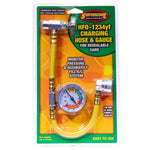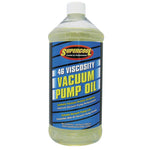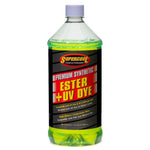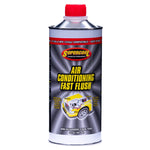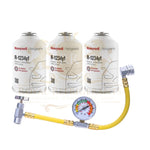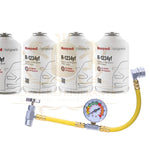You have no items in your shopping cart.
Everything You Need to Know About REFRIGERATION REGULATIONS CA 2025 for HVAC and Automotive Applications
Here’s a full overview of the key 2025-era refrigerant regulations in California — especially how they affect HVAC and automotive applications. I’ll cover the legal basis, what’s changing in 2025, what specific requirements you should know, and how HVAC/auto businesses and techs can prepare.
1. Legal & regulatory background
California Air Resources Board (SB 1206)
-
SB 1206 is a California law that prohibits the sale and distribution of virgin HFC refrigerants above specified global-warming-potential (GWP) thresholds, starting January 1, 2025. ww2.arb.ca.gov+2forane.arkema.com+2
-
It applies to “bulk hydrofluorocarbons or bulk blends containing hydrofluorocarbons” used in refrigerants for refrigeration, air conditioning, heat pumps, foams, aerosols, etc. ww2.arb.ca.gov+1
-
Under SB 1206:
-
Starting Jan 1 2025, virgin refrigerants with a GWP > 2,200 may not be sold. forane.arkema.com+2ww2.arb.ca.gov+2
-
Starting Jan 1 2030, virgin refrigerants with a GWP > 1,500 may not be sold. ww2.arb.ca.gov+1
-
Starting Jan 1 2033, virgin refrigerants with a GWP > 750 may not be sold. Refrigerants Center, inc+1
-
-
Importantly: the law allows reclaimed refrigerants (used/reprocessed refrigerants) under defined conditions. ww2.arb.ca.gov
Automotive A/C container regulation
-
CARB also regulates “Small Containers of Automotive Refrigerant” for do-it-yourself (DIY) vehicle A/C servicing. For example: regulation amendments took effect July 1 2024, and further deposit/return program changes take effect Jan 1 2025. ww2.arb.ca.gov
-
These rules aim to reduce uncontrolled releases of refrigerant (particularly R-134a) into the atmosphere. ww2.arb.ca.gov
-

2. What changes in 2025 & what that means for HVAC / automotive
Key changes effective Jan 1 2025
-
As noted: any virgin (new) HFC refrigerant in California with GWP > 2,200 is banned from sale. That affects many common refrigerants used in HVAC or refrigeration. ww2.arb.ca.gov+1
-
For automotive DIY containers: The deposit & return program for refrigerant containers ends Jan 1 2025. That means consumers buying small cans may see changes in refunds and program administration. ww2.arb.ca.gov
-
For HVAC / refrigeration equipment owned by the State: Beginning Jan 1 2025, HFCs with GWP > 750 that are not reclaimed cannot be used for maintenance/leak replenishment in state-owned stationary equipment. (Per SB 1206) ww2.arb.ca.gov
What this means in practice
-
If you are servicing or installing HVAC systems in California: If the refrigerant you intend to use is new/virgin and has GWP > 2,200, you cannot legally buy or use it for new equipment (or for servicing, depending on the rule) in California after Jan 1 2025.
-
For automotive A/C DIY cans and servicing: The container-deposit rules will change; the regulatory focus is on preventing leaks from small containers.
-
For older equipment / servicing existing systems: While the law targets sale of virgin refrigerants, there are often allowances for reclaimed refrigerants, servicing existing equipment, etc. So immediate replacement of all systems is not required in most cases — but planning is prudent.
Examples of affected refrigerants
-
According to regulatory summaries, refrigerants like R-404A, R-507, R-422B, R-428A, etc. commonly used in refrigeration/HVAC are impacted by the >2,200 GWP ban. Refrigerants Center, inc+1
-
For HVAC systems with refrigerants like R-410A (GWP ~2088) — the rule does not ban R-410A starting Jan 1 2025 under the >2,200 threshold, but note: the next threshold (>1,500) is Jan 1 2030. That means R-410A is still allowed for now under the virgin sale rule, but the long-term plan is a phase-down. ww2.arb.ca.gov+1
3. What HVAC / Automotive Professionals Should Do to Prepare
For HVAC contractors, refrigeration techs, installers
-
Audit your refrigerants in stock: Check which refrigerants you currently purchase/use, and note their GWP values.
-
Check compliance with SB 1206: If any refrigerant you buy is virgin and has GWP > 2,200, you’ll need to transition away or use reclaimed product after Jan 1 2025.
-
Plan for equipment life cycle: Since many systems are designed for certain refrigerants, consider whether retrofits or new systems using low-GWP refrigerants might be the most cost-effective long-term solution.
-
Work with suppliers: Make sure your supply chain knows the rules and can provide reclaimed refrigerants or lower-GWP options.
-
Educate clients/owners: Many clients may not understand the regulatory shift; explain how refrigerant changes may affect maintenance, cost, and equipment replacement decisions.
-
Maintain good records: Document purchases, refrigerant charges, leak repair work, refrigerant recovery, and reclamation as required by law/standards.
-
Stay up to date on upcoming thresholds: The GWP threshold phases continue (2030, 2033) so long-term planning is vital.
For automotive service shops
-
DIY refrigerant container rules: If you sell small cans of refrigerant (to consumers) or you service automotive A/C systems, be aware of the deposit/return container program changes effective Jan 1 2025. ww2.arb.ca.gov
-
Refrigerant reuse / recovery: Ensure that when servicing vehicles you are using certified recovery equipment and following best practices to avoid illegal venting.
-
Software/tracking: Keep records of refrigerant use, recovery, and disposal as required.
-
Client communication: Explain to vehicle owners that certain refrigerants may become more expensive or harder to source, so preventive maintenance is more important.
4. Key Takeaways & Action Items
-
Beginning Jan 1 2025 in California, virgin HFC refrigerants with GWP > 2,200 cannot be sold. That significantly impacts many high-GWP refrigerants.
-
Reclaimed (i.e., previously used) refrigerants are still permitted, so using reclaimed product is a compliance path.
-
The regulations don’t require every system to be replaced immediately—but they do change what refrigerants you can legally buy/use moving forward.
-
For HVAC/auto professionals: stock review, supplier coordination, client education, documentation, and preventative planning are essential.
-
Long-term: Additional thresholds (GWP > 1,500 in 2030; > 750 in 2033) mean further changes are coming — so laying groundwork now is smart.
-
For vehicle A/C and small container use: rules around container management, deposit/return programs, and leak prevention are in effect.
 English
English

